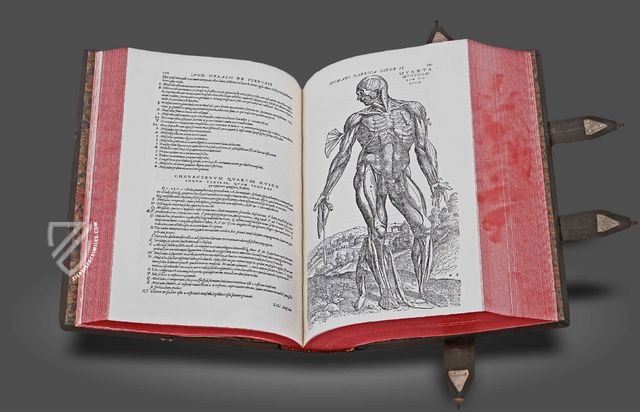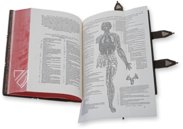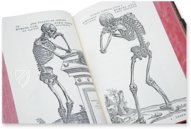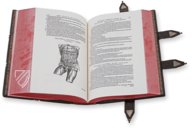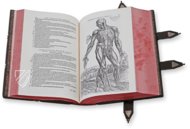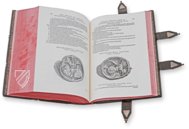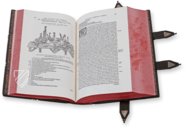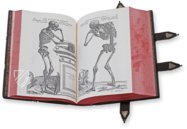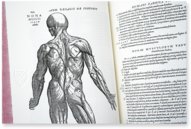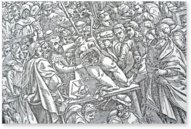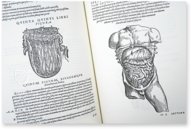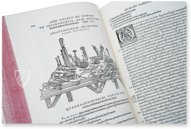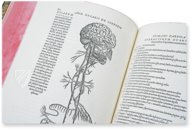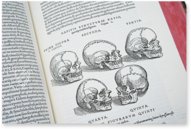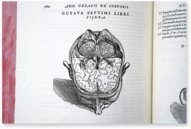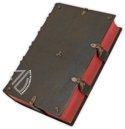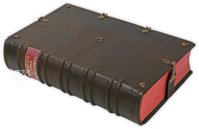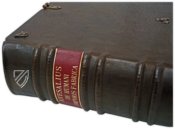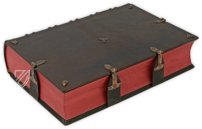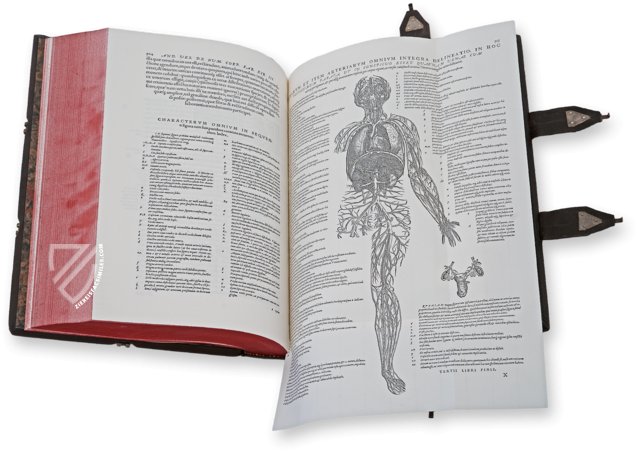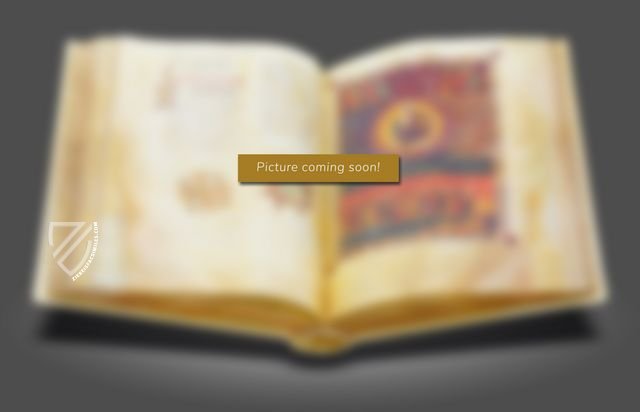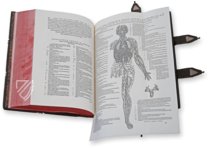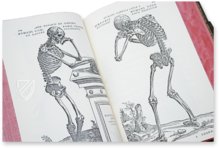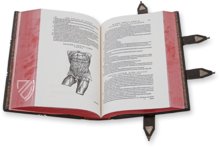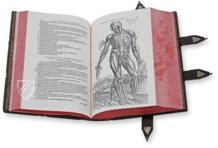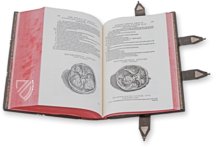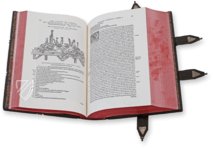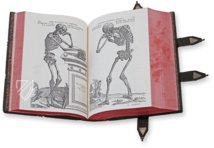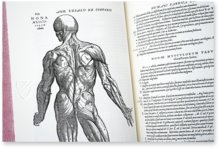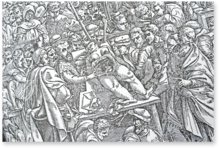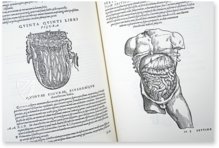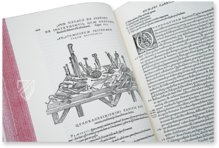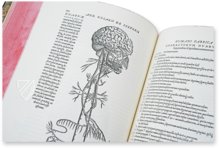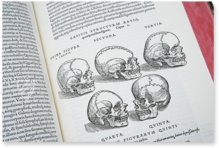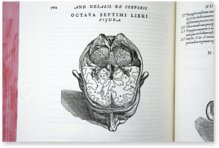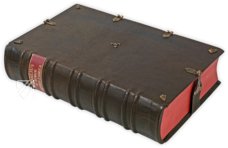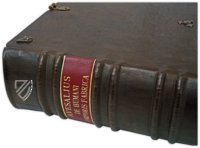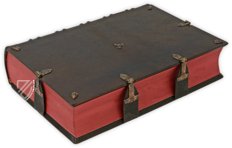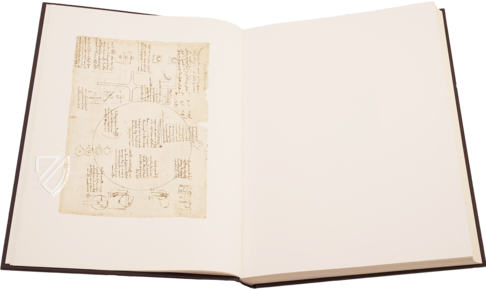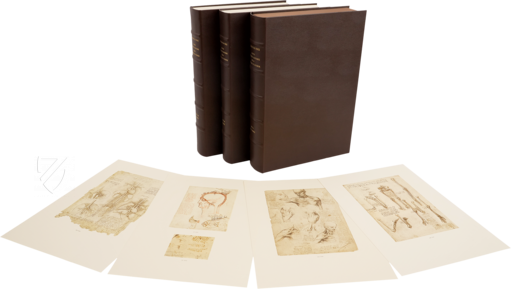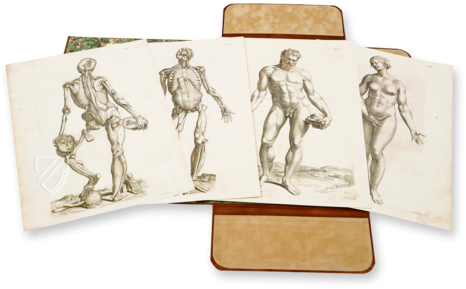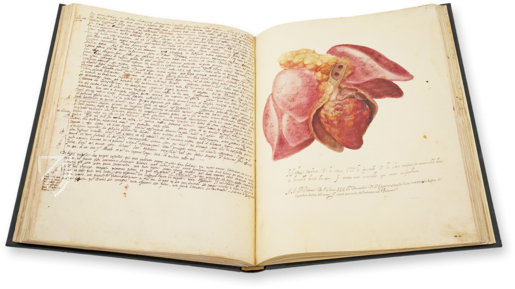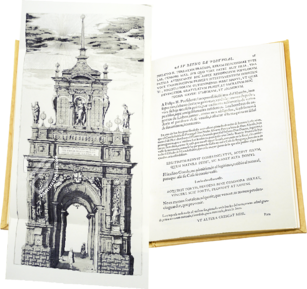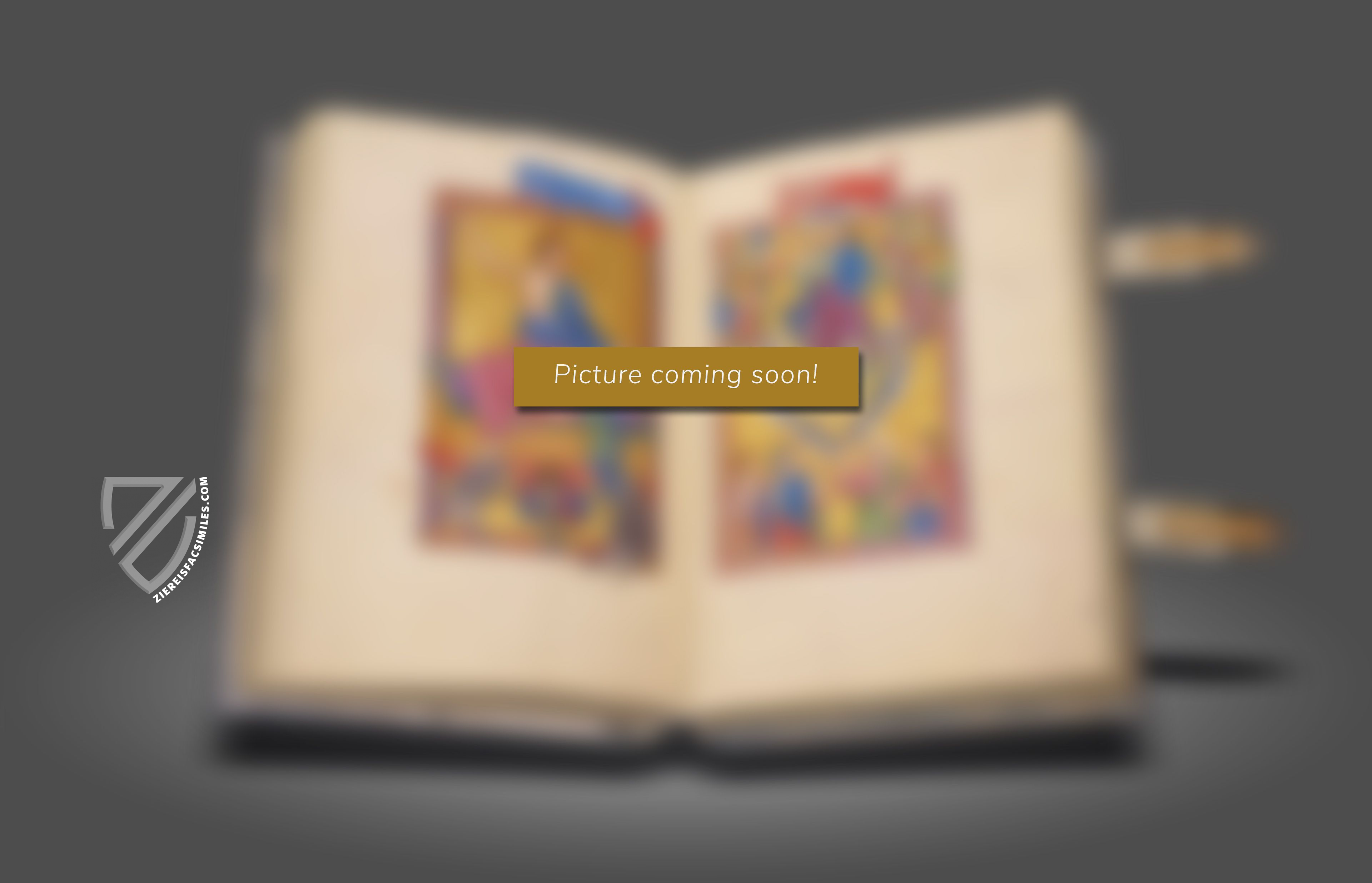Andreas Vesalius: De Humani Corporis Fabrica
(1,000€ - 3,000€)
In the mid-16th century, the dissection of human cadavers was considered to be an absolute taboo and was sometimes harshly penalized. Medicinal and anatomical findings were gained from the exploration of animal cadavers. This was not enough for the ambitious medical student Andreas Vesalius. He obtained corpses in adventurous cloak-and-dagger operations from graveyards and used them to conduct his studies, which make up the cornerstone of modern anatomy. Vesalius recorded his findings in his anatomical atlas De humani corporis fabrica. This medical treatise is one of the most important works on human anatomy to have ever been written and is illustrated with masterful woodcuts.
Andreas Vesalius: De Humani Corporis Fabrica
Though Vesalius’ work was not the first such work based on actual autopsy, nor even the first work of this era, the quality of its production – highly detailed and intricate plates – and the likelihood that the artists who produced it were present at the dissections themselves made it into an instant classic. Vesalius had the work published at the age of 28, taking great pains to ensure its quality. The more than 250 illustrations are of great artistic merit and are generally attributed by modern scholars to the “studio of Titian”. This splendidly illustrated codex represents a cornerstone of modern medicine.
Woodcuts of the Highest Quality
These woodcuts were greatly superior to the illustrations in anatomical atlases of the day, which were never made by anatomy professors themselves. The woodcut blocks were transported to Basel, Switzerland as Vesalius wished that the work be published by one of the foremost printers of the time, Johannes Oporinus. Vesalius’ written directions to Oporinus (the printer) were so valuable the printer decided to include them. The illustrations were engraved on wooden blocks, which allowed for very fine artistic value. The book contains discussions and illustrations of the structure, function and pathology of the human body. The different parts are named in Latin, Greek and Hebrew. The author notes the opinions of other authorities as well as expressing his own. He also includes tales of his experiences in grave-robbing and dissection. The illustrations portray the human body in progressive stages of dissection, set before a landscape and posed according to the taste of the day for the sculpture of Classical antiquity. In one plate, for example, a skeleton rests its elbow on a tomb with its skull bent in contemplation of mortality – though perhaps a little too late! Soon after publication, many pirate copies appeared and brought Europe-wide fame to Vesalius.
About the Author
Andreas Vesalius (1514–1564) was probably the most famous anatomist of the late Renaissance. He relied on the experiences of his own dissections and provided a description of the human body with a previously unprecedented level of detail, an uncommon practice for his time. He was born in Brussels on either the last day of 1514 or on the first day of 1515. He came from a family of physicians, which must be the reason for his devotion to surgery and anatomy. At age 15 he left Brussels to study in Louvain, later studied medicine at Montpellier and Paris before returning to Louvain again, but this time not as a student but to teach anatomy. Later he lectured at the prestigious university of Padua, and was a guest lecturer at the University of Bologna. He was only 28 years old when he published his great works, the De Humani Corporis Fabrica libri septum and Epitome, the latter being the summarized version of the original, a cheaper and shorter version made specifically for his students to use. The collection of books are based on his Paduan lectures, during which he deviated from common practice by dissecting a corpse to illustrate what he was discussing. Dissections previously had been performed by a barber surgeon under the direction of a doctor of medicine, who was expected not to perform “manual labor”. Vesalius’ “hands-on” magnum opus presents a careful examination of the organs and the complete structure of the human body. It is for this reason that Vesalius is often considered to be the father of modern anatomy.
Creating the Codex
None of this would not have been possible without the many advances that had been made during the Renaissance, including both artistic developments with regard to literal visual representation and the technical development of printing refined woodcut engravings. Because of these developments and his careful, immediate involvement, he was able to produce illustrations superior to any that had been produced up to then. He commissioned the former Titian apprentice Jan van Kalkar to create the artistic and scientific illustrations of the book. After the book was published, Vesalius sent Emperor Charles V a beautiful copy bound in imperial purple silk and printed on parchment. When the Emperor received it, he called Vesalius to his court, and asked Vesalius to work as an imperial surgeon. Consequently, Vesalius turned down Cosimo de Medici, who offered him a place as a professor at the University of Padua. Over the next eleven years, Vesalius traveled with the court, treating injuries from battle or tournaments, performing postmortems, administering medications, and writing private letters addressing specific medical questions. After the abdication of Emperor Charles V, he continued at court in great favor with his son, Philip II, who rewarded him with a pension for life by making him a Count Palatine. In 1555, he published a revised edition of De humani corporis fabrica. In 1564, Vesalius went on a pilgrimage to the Holy Land. When he arrived in Jerusalem, he received a message from the Venetian senate requesting him again to accept the Paduan professorship, which had become vacant by the death of his friend and pupil Fallopius. After struggling for many days with the adverse winds, he was wrecked on the island of Zakynthos. He was buried somewhere in the island of Korfu in 1564.
Codicology
- Size / Format
- 890 pages / 38.5 × 25.0 cm
- Origin
- Switzerland
- Date
- 1555
- Epochs
- Style
- Illustrations
- More than 250 woodcut illustrations
- Content
- The anatomy of the human body is presented in both text and illustrations
- Artist / School
- Andreas Vesalius (author)
Jan Stephan van Calcar (engraver)
Johannes Oporinus (printer)
Andreas Vesalius: De Humani Corporis Fabrica
Title Page – Classroom Autopsy of a Human Cadaver
As the author looks out at the reader and points to the open abdomen of the cadaver, a mob of student is crowding about the table while others (flanking Death) watch from the gallery above. A textbook, possibly the treatise at hand, can be seen held in the hands of a young and clean-shaven medical student, whose colleagues gather around him on the left. Another is clutched to the breast of a man with deep-set eyes observing the autopsy with another old, bearded doctor on the right.
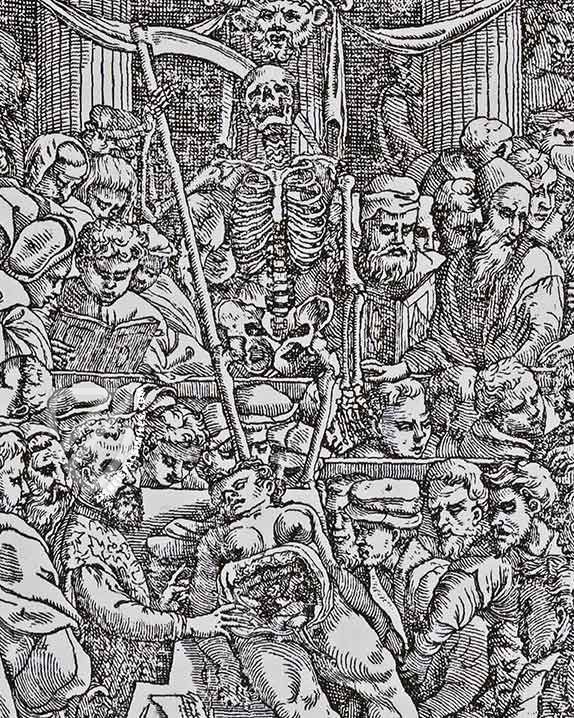
Andreas Vesalius: De Humani Corporis Fabrica
Title Page – Classroom Autopsy of a Human Cadaver
Dissecting the human body has long been controversial. Before being banned by Christian theologians, Western restrictions on “violating” a human body date back to Greek and Roman antiquity. Holy Roman Emperor Frederick II (1194–1250) was the first to require medical students to attend human dissections and autopsies were common in European universities by the time of Renaissance.
Andreas Vesalius, the author of this text, is pictured to the left of the corpse with his right hand resting lightly on its exposed abdomen. He is in the center of the detailed woodcut depicting a crowded operating theater full of people jockeying for a view of the autopsy. The specter of death in the form of a scythe-wielding skeleton stands at the head of the dissection table.
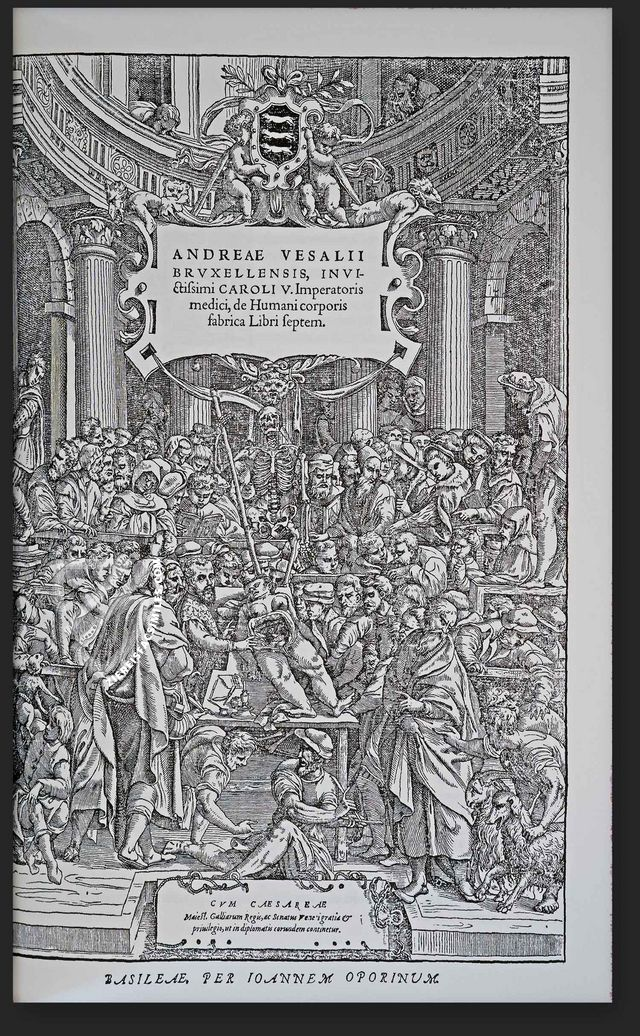
#1 Andreas Vesalius: De Humani Corporis Fabrica
(1,000€ - 3,000€)
#2 Andreas Vesalius: De Humani Corporis Fabrica
(1,000€ - 3,000€)
- Treatises / Secular Books
- Apocalypses / Beatus
- Astronomy / Astrology
- Bestiaries
- Bibles / Gospels
- Chronicles / History / Law
- Geography / Maps
- Saints' Lives
- Islam / Oriental
- Judaism / Hebrew
- Single Leaf Collections
- Leonardo da Vinci
- Literature / Poetry
- Liturgical Manuscripts
- Medicine / Botany / Alchemy
- Music
- Mythology / Prophecies
- Psalters
- Other Religious Books
- Games / Hunting
- Private Devotion Books
- Other Genres
- Afghanistan
- Armenia
- Austria
- Belgium
- Colombia
- Croatia
- Czech Republic
- Denmark
- Egypt
- Ethiopia
- France
- Germany
- Hungary
- India
- Iran
- Iraq
- Israel
- Italy
- Japan
- Luxembourg
- Mexico
- Morocco
- Netherlands
- Peru
- Poland
- Portugal
- Russia
- Serbia
- Spain
- Sri Lanka
- Sweden
- Switzerland
- Syria
- Turkey
- Ukraine
- United Kingdom
- United States
- Uzbekistan
- Aboca Museum
- Ajuntament de Valencia
- Akademie Verlag
- Akademische Druck- u. Verlagsanstalt (ADEVA)
- Aldo Ausilio Editore - Bottega d’Erasmo
- Alecto Historical Editions
- Alkuin Verlag
- Almqvist & Wiksell
- Amilcare Pizzi
- Andreas & Andreas Verlagsbuchhandlung
- Archa 90
- Archiv Verlag
- Archivi Edizioni
- Arnold Verlag
- ARS
- Ars Magna
- ArtCodex
- AyN Ediciones
- Azimuth Editions
- Badenia Verlag
- Bärenreiter-Verlag
- Belser Verlag
- Belser Verlag / WK Wertkontor
- Benziger Verlag
- Bernardinum Wydawnictwo
- BiblioGemma
- Biblioteca Apostolica Vaticana (Vaticanstadt, Vaticanstadt)
- Bibliotheca Palatina Faksimile Verlag
- Bibliotheca Rara
- Boydell & Brewer
- Bramante Edizioni
- Brepols Publishers
- British Library
- C. Weckesser
- Caixa Catalunya
- Canesi
- CAPSA, Ars Scriptoria
- Caratzas Brothers, Publishers
- Carus Verlag
- Circulo Cientifico
- Club Bibliófilo Versol
- Club du Livre
- CM Editores
- Collegium Graphicum
- Collezione Apocrifa Da Vinci
- Comissão Nacional para as Comemorações dos Descobrimentos Portugueses
- Coron Verlag
- Corvina
- CTHS
- D. S. Brewer
- De Agostini/UTET
- De Schutter
- Deuschle & Stemmle
- Deutscher Verlag für Kunstwissenschaft
- DIAMM
- Droz
- E. Schreiber Graphische Kunstanstalten
- Ediciones Boreal
- Ediciones Grial
- Ediclube
- Edições Inapa
- Edilan
- Editalia
- Edition Georg Popp
- Edition Leipzig
- Edition Libri Illustri
- Editiones Reales Sitios S. L.
- Éditions de l'Oiseau Lyre
- Editions Medicina Rara
- Editorial Casariego
- Editorial Mintzoa
- Editrice Antenore
- Editrice Velar
- Edizioni Edison
- Egeria, S.L.
- Eikon Editores
- Electa
- Enciclopèdia Catalana
- Eos-Verlag
- Ephesus Publishing
- Eugrammia Press
- Extraordinary Editions
- Fackelverlag
- Facsimila Art & Edition
- Facsimile Editions Ltd.
- Facsimilia Art & Edition Ebert KG
- Faksimile Verlag
- Feuermann Verlag
- Folger Shakespeare Library
- Franco Cosimo Panini Editore
- Friedrich Wittig Verlag
- Fundación Hullera Vasco-Leonesa
- G. Braziller
- Gabriele Mazzotta Editore
- Gebr. Mann Verlag
- Gesellschaft für graphische Industrie
- Getty Research Institute
- Giovanni Domenico de Rossi
- Giunti Editore
- Graffiti
- Grafica European Center of Fine Arts
- Guido Pressler
- Guillermo Blazquez
- H. N. Abrams
- Harrassowitz
- Helikon
- Hendrickson Publishers
- Henning Oppermann
- Herder Verlag
- Hes & De Graaf Publishers
- Hoepli
- Hortus Deliciarum
- Houghton Library
- Hugo Schmidt Verlag
- Idion Verlag
- Il Bulino, edizioni d'arte
- ILte
- Imago
- Insel Verlag
- Instituto de Estudios Altoaragoneses
- Instituto Nacional de Antropología e Historia
- Istituto dell'Enciclopedia Italiana - Treccani
- Istituto Ellenico di Studi Bizantini e Postbizantini
- Istituto Geografico De Agostini
- Istituto Poligrafico e Zecca dello Stato
- Italarte Art Establishments
- J. Thorbecke
- Jan Thorbecke Verlag
- Johnson Reprint Corporation
- Jugoslavija
- Karl W. Hiersemann
- Kasper Straube
- Kaydeda Ediciones
- Konrad Kölbl Verlag
- Kurt Wolff Verlag
- La Liberia dello Stato
- La Linea Editrice
- La Meta Editore
- Lambert Schneider
- Landeskreditbank Baden-Württemberg
- Leo S. Olschki
- Les Incunables
- Library of Congress
- Libreria Musicale Italiana
- Lichtdruck
- Lito Immagine Editore
- Lumen Artis
- Lund Humphries
- M. Moleiro Editor
- Maison des Sciences de l'homme et de la société de Poitiers
- Manuscriptum
- Maruzen-Yushodo Co. Ltd.
- MASA
- McGraw-Hill
- Militos
- Millennium Liber
- Müller & Schindler
- National Library of Wales
- Neri Pozza
- Nova Charta
- Oceanum Verlag
- Odeon
- Orbis Mediaevalis
- Orbis Pictus
- Österreichische Staatsdruckerei
- Oxford University Press
- Pageant Books
- Parzellers Buchverlag
- Patrimonio Ediciones
- Pattloch Verlag
- PIAF
- Pieper Verlag
- Plon-Nourrit et cie
- Prestel Verlag
- Princeton University Press
- Prisma Verlag
- Priuli & Verlucca, editori
- Pro Sport Verlag
- Propyläen Verlag
- Pytheas Books
- Quaternio Verlag Luzern
- Reales Sitios
- Recht-Verlag
- Reichert Verlag
- Reichsdruckerei
- Riehn & Reusch
- Roberto Vattori Editore
- Rosenkilde and Bagger
- Roxburghe Club
- Salerno Editrice
- Sarajevo Svjetlost
- Schöck ArtPrint Kft.
- Scolar Press
- Scrinium
- Scripta Maneant
- Scriptorium
- Siloé, arte y bibliofilia
- SISMEL - Edizioni del Galluzzo
- Sociedad Mexicana de Antropología
- Sorli Ediciones
- Stainer and Bell
- Styria Verlag
- Sumptibus Pragopress
- Szegedi Tudomànyegyetem
- Taberna Libraria
- Tarshish Books
- Taschen
- Tempus Libri
- Testimonio Compañía Editorial
- Thames and Hudson
- The Clear Vue Publishing Partnership Limited
- The Facsimile Codex
- The Folio Society
- The Marquess of Normanby
- The Richard III and Yorkist History Trust
- Tip.Le.Co
- TouchArt
- TREC Publishing House
- TRI Publishing Co.
- Trident Editore
- Typis Regiae Officinae Polygraphicae
- Universidad de Granada
- University of California Press
- University of Chicago Press
- Urs Graf
- Vallecchi
- Van Wijnen
- VCH, Acta Humaniora
- VDI Verlag
- Verlag für Regionalgeschichte
- Verlag Styria
- Vicent Garcia Editores
- W. Turnowsky
- Wiener Mechitharisten-Congregation (Wien, Österreich)
- Wissenschaftliche Buchgesellschaft
- Xuntanza Editorial
- Zollikofer AG

